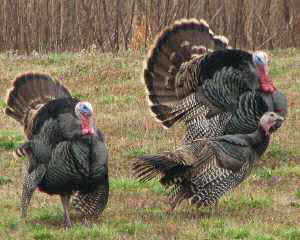See Also: Turkey Recipes WILD TURKEYSEarthTalk
From the Editors of E/The Environmental Magazine Dear EarthTalk: How are wild turkeys faring in the U.S.? Occasionally I'll see some crossing the road, but how well could they be doing with all the development going on around them?
-- Harley Barton, Hingham, MA (8/1/10) No one can be sure how many tens of millions of wild turkeys roamed what was to become the continental United States when the Puritans dined on them at the first Thanksgiving in 1621 near Plymouth Rock, but there were obviously enough of the birds to make them easy prey. By the late 1700s turkeys across the frontier were being harvested with reckless abandon. The food shortages that accompanied the Civil War accelerated demand for wild turkeys, and their numbers started to dwindle to startlingly low levels. By the early 1900s, only some 30,000 wild turkeys remained; the birds had been extirpated across almost half of their former range.
But things started to turn around for wild turkeys in the 1920s. For starters, millions of acres cleared by the pioneers began to regenerate into the type of woodland habitat where the birds could thrive. But the real boost for wild turkeys came in the form of legislation. At the urging of hunters, state wildlife agencies, and the firearms industry, Congress passed the landmark Federal Aid in Wildlife Restoration Act (Pittman-Robertson Act) in 1937, which placed an excise tax on guns, ammo and other hunting gear. A portion of the billions of dollars raised from the law have been and continue to be allocated toward restoring wildlife habitat across the country. 
Photo: Vicki DeLoach, courtesy Flickr.
By the early 1900s, only 30,000 wild turkeys roamed the continental U.S., having been exterminated across almost half their former range. Today, as many as seven million roam the countryside across every U.S. state except Alaska .
Pictured: Wild turkeys photographed near Little River, Georgia. |
|
By 1959, wild turkey numbers jumped sixteen fold, topping half a million birds across the U.S. A 1973 wild turkey census by the then newly formed National Wild Turkey Federation (NWTF) turned up something like 1.3 million birds. NWTF, which was founded by hunters to aid in turkey conservation efforts, would turn out to be instrumental in shepherding the wild turkey's recovery by channeling hundreds of millions of dollars in charitable donations and grants into habitat recovery and bird relocation projects. Although the birds will likely never return to the population levels pre-dating white settlement, they haven't been healthier in 300+ years. These days as many as seven million wild turkeys roam the countryside and can be found in every U.S. state besides Alaska.
Of course, our success in restoring habitat for wild turkeys has also been beneficial for a wide range of wild animals. Conservations credit the visionary Pittman-Robertson Act (along with the hard work of dedicated wildlife managers) as instrumental in the recovery of not only wild turkeys but also once struggling populations of white-tailed deer, pronghorn antelope, wood duck, beaver, black bear, Canada goose, American elk, desert bighorn sheep, bobcat, mountain lion, and several species of predatory birds.
Besides the animals and biodiversity benefitting from species recovery, hunters can also rejoice, especially given that it has been their money that has funded many of the projects to restore habitat where they hunt. Turkey hunting is traditionally an autumn pursuit, culminating at Thanksgiving, of course, but each state has its own laws regarding when and where turkey hunting is allowed. NWTF provides a free online state-by-state “Fall Turkey Hunting Guide” with hunting season dates and other pertinent information to help hunters plan their next trip wherever it may take them in the continental U.S. The website also serves as an invaluable resource for information and resources pertaining to conservation, hunting and other topics related to wild turkeys. CONTACT: National Wild Turkey Federation, www.nwtf.org
SEND YOUR ENVIRONMENTAL QUESTIONS TO: EarthTalk®, c/o E – The Environmental Magazine, P.O. Box 5098, Westport, CT 06881; earthtalk@emagazine.com E is a nonprofit publication. Subscribe: www.emagazine.com/subscribe; Request a Free Trial Issue: www.emagazine.com/trial
| 